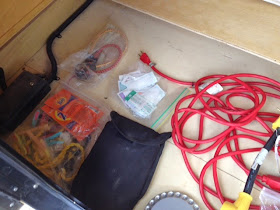"We are having fun learning the ins and outs of teardropping," Joy said. "We love the time when we’re able to get away and we love bringing “the darlings” with us. The darlings are our two black labs, Rudy and Holly. They will be 12 years old this Christmas. Rudy is short for Rudolph and Holly is short for Holly Berry, our 2002 Christmas gifts.They’ve been going to work with us every day since they were seven weeks old, but both have slowed down in the last couple of years. Both have health issues and have their limitations, especially Rudy."
Why did you decide to get a teardrop?
Ernie had been looking into getting one for some time. We hadn’t been camping in a lot of years but knew we wanted to get back to it. We wanted something simple that would be easy to tow and wouldn’t require a gas-guzzling vehicle to pull it. We also wanted something that would get us off the ground to sleep in, yet still allow us to enjoy the outdoors.
Did you have to consider how the dogs would fit?
We didn’t agree on this topic. I wanted the dogs to sleep in the teardrop with us, but didn’t want to admit they were too big for that. So our plan was to buy them their own tent. We wanted one that would attach to our teardrop but still haven’t found the perfect one. We settled for an EZ-Up tent as a temporary solution and set it up close to our teardrop. The darlings have the entire tent for their beds and toys and they’re happy.
What are the sleeping arrangements like?
The darlings are very happy sleeping in their very own tent together. Ernie and I sleep in the teardrop. When Ernie goes camping by himself Rudy gets to sleep in the teardrop with him. Holly doesn’t go with Ernie because she has separation anxiety when I’m not around.
A couple of times I couldn’t get away from work to go camping but Ernie could and was anxious to take the teardrop out again. I didn’t want him to go alone so he took Rudy along for company on two trips. With just the two of them going, Rudy was able to sleep in the teardrop with Ernie. Ernie said Rudy can really stretch out and also added, "...that dog knows how to relax!" The mattress that came with the teardrop was good but we added a very plush mattress topper to improve it. Now it’s definitely very, very cozy. Ernie said Rudy takes up more room than I do. They watched movies at night on our TV in the teardrop and Ernie had his furry companion to cozy up with. Ernie was telling me there is no way all four of us could fit in there after sleeping with Rudy.
What items do you have to bring for the dogs?
Treats, tent, foldable fencing, dog beds, leashes, dog food, water and food bowls, treats, toys and medicine. Did I mention treats? We have to bring our propane camp ring because Holly is afraid of the smoke from campfires. If there’s too much smoke from campfires nearby, she’s happy relaxing in the teardrop until it’s time to go to bed.
What logistics do you keep in mind?
We have to stop more often to allow them to stretch their legs and go potty.
What's the best part about camping with dogs?
First of all; they love going for rides in the car. They love camping and we’re able to spend more quality time with them.
What are some challenges?
We’re limited on some of the places we can go because they can’t be left alone for long periods of time.
Rudy and Holly, what do you think of teardrop camping and what's your favorite camp food?
We LOVE getting out of the house and going camping with Mommy and Daddy. It's fun sleeping in our new tent and smelling all the smells of the great outdoors and we enjoy swimming any chance we get. The fresh air makes us really hungry! We enjoy our dog food and doggie treats but also enjoy any leftovers Mommy and Daddy want to share.













































